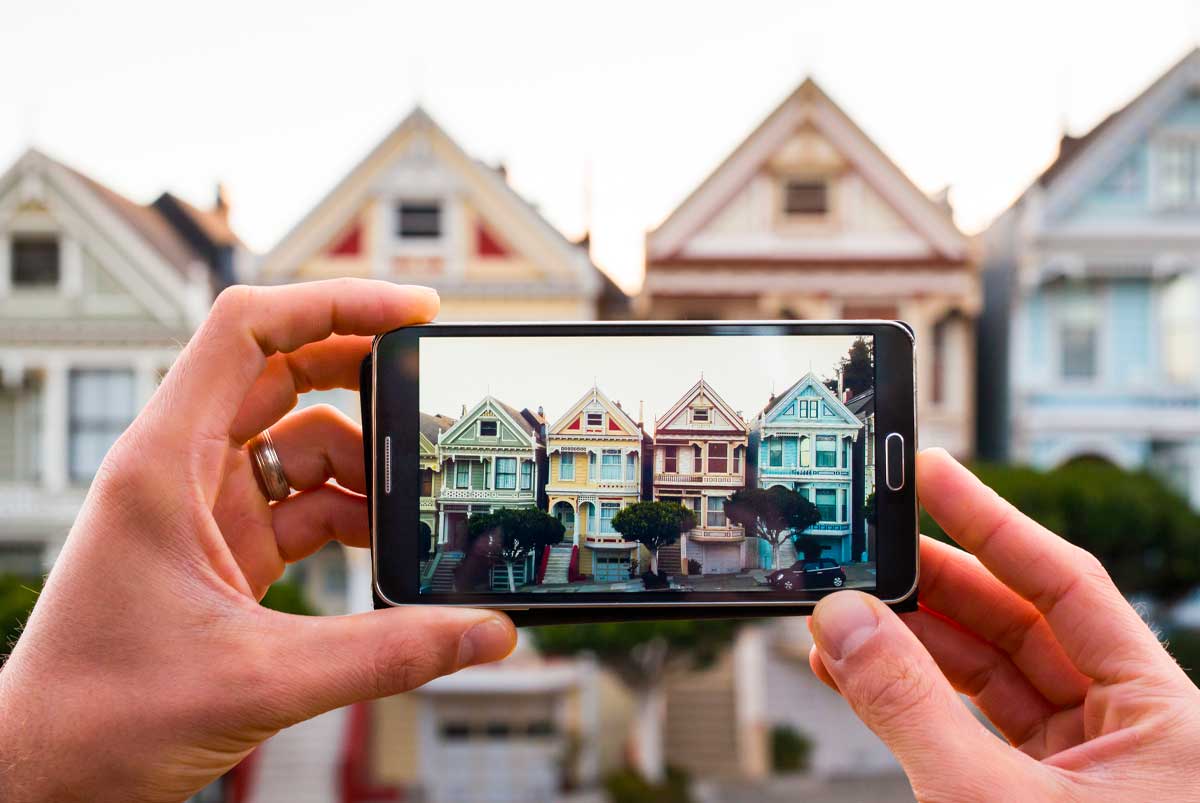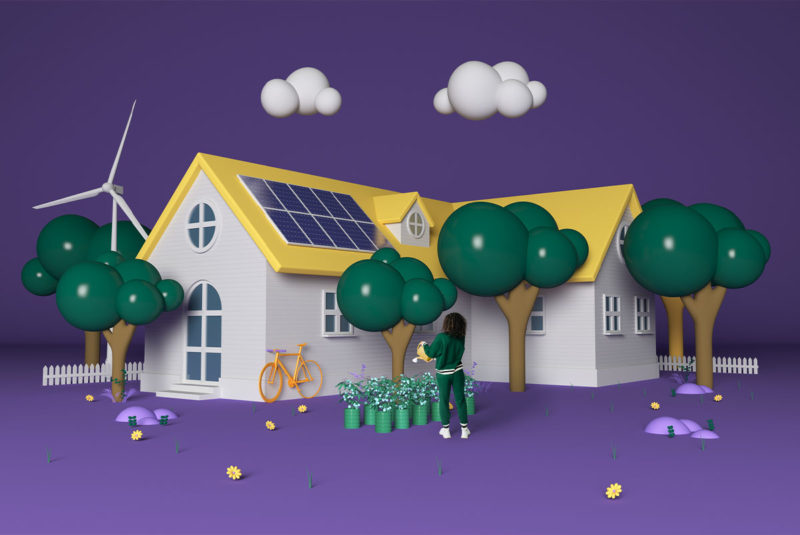Ready To Buy a Home?
Get Approved to Buy a Home
Rocket Mortgage® lets you get to house hunting sooner.
You’re selling your house, but potential buyers may not want to attend an open house or even a private tour of your home. On the flip side, you may want to avoid devoting time and energy to preparing for in-person tours or scheduling them. And finding someplace else to be while your home is being shown can also be a pain. Enter virtual home tours.
While still photos of your home can give an idea of what it’s like, virtual tours simulate being there.
But how do you create a virtual tour of your home? And how do you use a virtual tour to market your home? Let us show you (and your real estate agent) how a virtual tour can help you sell your home. Then you – and prospective buyers – can sit back, relax and enjoy the show.
What Is a Virtual Tour?
A real estate virtual tour (also known as a 3D virtual tour or 3D walkthrough) is a digital tour of your home.
A well-done virtual tour uses interior and exterior images of a home to offer viewers a full, 360-degree scan of the property. Viewers can control their movements as they tour the home. Ideally, the viewer will be able to look up to the ceiling and down to the floor and turn 360 degrees. Viewers can even walk through doorways into other rooms and look out windows using clickable hotspots. But there are limitations. Viewers won’t be able to turn on a faucet or swipe for dust inside a kitchen cabinet. Aside from that, a good virtual tour can be the next best thing to being there in person.
You can create an interactive, virtual tour by using software to stitch together a series of panoramic photos. And the video gets shared online, usually on a real estate listing site.
Does it sound like hard work? Depending on how tech savvy you are, it might be. But whether you’re a homeowner or real estate agent, the benefits of a virtual tour are undeniable.
What Are the Benefits of Virtual Tours?
Here are some common benefits of virtual tours:
Increased views and sales
The more people see your listing, the more likely you are to get offers. According to a recent survey, 55% of home buyers said they would purchase a house sight unseen if the listing featured a 360-degree virtual tour that let them use measurement tools (a feature in some virtual tour software packages).[1]
Does your real estate agent use virtual tours in listings? Nearly 80% of house hunters from the survey admitted they’d switch to a real estate agent who used interactive tours to sell properties.[1]
More potential buyers
With a virtual tour, you’ll expose your home to more buyers in your area – and outside your area, too, especially out-of-state buyers.
If a prospective buyer can’t see your home in person for any reason, a virtual tour is a virtual key to walk through your home from the comfort of their screens.
Weeds out non-serious buyers
With a virtual tour, you can forgo an in-person open house. This stems the tide of people who aren’t serious buyers and attend open houses for fun. Plus, potential buyers can decide if a home might be right for them without you having to prep your home for a lot of showings.
8 Steps To Make a Spielberg-Level Virtual Tour
You always thought you’d make a fine Hollywood director and now’s your chance to prove it. Here are eight steps to making your virtual tour – and home – stand out.
1. Plan out time and tools
Before you shine a spotlight on that new hot tub and start your virtual tour creation, there are a few considerations to weigh:
Equipment
You’ll need to decide whether you need a camera and which one you’d like to use. Go through online reviews of 360-degree cameras – and stick to your budget. There’s no need to break the bank, especially with budget-friendly options out there.
Besides the price, pay attention to the camera’s resolution and stabilizing features so you can avoid blurry, shaky images. A DSLR camera or your trusty smartphone can be used to take panoramic photos and create your virtual tour, too. And you may even find camera rentals near you.
Software
Research software and apps that will put your virtual walkthrough together. Read reviews and see which software works best with what equipment. Sometimes virtual tour software companies will offer discounts on a 360-degree camera.
Time
Set aside time to learn how to use your equipment and software. You’ll need time to prep your home, take the images and stitch everything together into the virtual tour. The size of your home and your level of expertise will play a large part in how long this takes, so plan on devoting lots of hours to this project.
2. Create a walking tour of the home’s floor plan
A good walking tour should help a viewer visualize a home’s floor plan. Decide how you want the viewer to experience the home. Your front door is usually a good place to start.
Make a list of all the rooms and shots you’ll need to include in each one. Try to capture each room from the center of the room, but if that isn’t the most ideal angle, walk around the room to find the best spot. You can even put a piece of tape on the floor so you know where to stand when you take the picture.
Don’t forget closets and cupboards. Capture images anywhere a potential buyer would look. Buyers typically want to see more than kitchens and bathrooms. Features like a walk-out basement or pretty bay window are important to include.
Systems should be captured as well. Take photos of your central air conditioning unit and go to the basement to get a photo of the electrical panel.
3. Get your home film-ready with staging
No one wants to see a toilet with the seat up. And that coil of flypaper hanging over the kitchen table might turn buyers off.
Home staging is an important part of getting your place ready for people to see it. It’s all about presenting your home so its features shine through and appeal to the widest range of potential home buyers.
Remove distracting elements, clutter and personal items that might make it difficult for prospective buyers to picture themselves living in the home. If you’ve got unusual taste in wallpaper or paint colors (chartreuse and salmon polka dots, for instance), consider replacing them with a neutral coat of paint. Remember, you want to make the tour less about you and your tastes and more about creating an environment where buyers can imagine themselves living their best lives.
So it should go without saying that a clean home will always win over a home filled with dusty knick knacks on every surface. Store personal mementos in a bin in the basement, attic or off-site. Make sure the only personal items that stay in the picture enhance a room’s look and function.
And don’t forget the outside! Make sure the yard looks great and there are no stray pieces of sports equipment or other items lying around. Make sure hardscapes like driveways or sidewalks are swept. Consider power washing the siding and cleaning windows inside and out.
4. Lighting is key
It’s a good idea to plan your shoot around natural lighting. If your home gets a lot of morning sun, opt to take your images in the morning. If the sun’s rays are going to play a leading role in your shots, take care not to shoot directly into the sunlight and beware of back-lit images that leave foreground areas in the shadows.
Don’t be afraid to experiment with lighting. Consider adding some photo lights to brighten darker areas. That mudroom with all the cubbies might be a great feature, but if the viewer can’t see it, it could get overlooked.
5. Keep it steady
A shaky, interactive video looks unprofessional, and even worse, can be jarring and distract from the features in your home.
Use a monopod or tripod to maintain a smooth shot. If you’re using a camera with a shoulder strap, you can use the strap to create tension while you’re shooting.
6. Test, test, test
Test your walkthrough a few times and take some test shots. How do they look? This is your chance to make adjustments. Do you need more light? Should you open or close some or all of your window shades? Does your house photograph better at a different time of day? Didn’t notice that pile of papers on your desk? Clean up every area you plan on shooting. And beware of mirrors or other reflective surfaces so you aren’t inadvertently in the shot.
7. Post-production
Using your software, You’ll stitch your images together during post-production, upload your photos and start editing. Depending on what software you get, you may be able to add an audio track and designate clickable hotspots.
8. Get your virtual tour online
Your software will provide a link to your tour. Add that link to your social media profiles or posts, your website or the listing for your home. If you plan on sending a group email about your sale to family and friends, don’t forget to add the link in the email. If you’re an agent, make sure the link is in any message you send to your client list.
Look Into Virtual Tour Companies
If you’re nervous about creating a virtual tour on your own, consider hiring a virtual tour company. It’s a popular option for many real estate agents and homeowners.
Ask around and get recommendations on companies in your area. Find out how many tours they’ve done and uploaded. Creating a virtual tour is a big undertaking. If a quote seems too low, it might be a red flag.
You should also ask the company if they can handle marketing the virtual tour. If that’s a yes, make sure they explain how they’ll get your home in front of the most screens.
Lights, Camera, Sold
A virtual tour can be a great tool for selling your home. But it has to be done right, or it can detract from a prospective home buyer’s experience of your home.
Taking time to stage your home and learning to use the equipment can make all the difference. And if you’d prefer to take a more hands-off approach to part of the sales process, you can always hire a professional to create a virtual tour for you.
Looking to make a change?
Whether you want to buy a house, refinance or take cash out, you’re not alone. The experts are just a click away.
The Short Version
- While still photos of your home can give an idea of what it’s like, virtual tours simulate being there
- With a virtual tour, you’ll expose your home to more buyers in your area – and outside your area, too
- You can create an interactive, virtual tour by using software to stitch together a series of panoramic photos
REALTOR® Magazine. “Survey: Consumers Strongly Prefer Listings With 3D Tours.” Retrieved June 2022 from https://magazine.realtor/daily-news/2020/01/27/survey-consumers-strongly-prefer-listings-with-3d-tours




